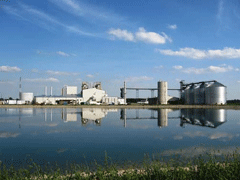Ethanol’s Bumpy Ride
Air Date: Week of December 5, 2008

Poetethanol. Poet, the largest privately-held ethanol producer.
The U.S. ethanol industry has had the pedal to the metal - until recently. Now some ethanol companies may be about to stall out. Jim Lane, chairman of the American Biofuels Council, tells host Bruce Gellerman about ethanol’s change in fortune.
Transcript
GELLERMAN: It’s Living on Earth, I’m Bruce Gellerman. It was just a few months ago that the ethanol industry was in high gear. With the price for gas at the pump soaring, the demand for ethanol – a fuel substitute made mostly from corn - was sky high, making corn growers and ethanol producers very happy and consumers very sad.
Well, what a difference a few weeks make. The economy has taken a sudden turn for the worse driving the demand for gas and ethanol into a ditch. Jim Lane is editor of the online daily “Biofuels Digest.” Mr. Lane, it’s always good to talk with you.
LANE: Good to be here.
GELLERMAN: You know until recently, the ethanol biz had been booming. What - just last year the number of ethanol processing plants in the U.S. increased by sixty percent.
LANE: That’s true. It was a boom business. And it’s still booming in terms of supply. There’s plenty of capacity coming on line, but it’s hard to make it a business these days. 15 percent are already in bankruptcy of the ethanol supply in the country, and that’s really a function of the economics of the business, because it’s the spread between the price of the feedstock which is usually corn. And that’s gone up and down a lot this year. It’s caused a lot of dislocation, and of course it’s capital-intensive business. It costs a lot of money to put an ethanol plant together and it’s tough to find capital in these strange economic times that we find ourselves in.
GELLERMAN: Seems like its feast or famine. The corn prices were two bucks a bushel, then they went to eight dollars a bushel and now they’re down to three, three-and-a-half dollars.
LANE: Yeah, they were at two for a long time – forty years at two. And they did take a large leap into the seven, eight dollar range. They had more to do with the fact that there was a real big crop failure in Europe and a lot of speculative money also moved into the market in the spring, so it was temporary, but boy it was tough. And a lot of these ethanol producers got scared, locked in when they saw prices at around six dollars and said, hey let’s, let’s go for that. Well, now they’re down to three fifty and that’s why they’re declaring bankruptcy left, right and center.

Jim Lane (Courtesy of Jim Lane)
GELLERMAN: Ah, so they bought it high and now they gotta sell it low.
LANE: That’s right. The price of ethanol – you can get ethanol, a gallon of ethanol in Sacramento for $1.19 a gallon for E 85, it’s 85% ethanol. And you just can’t make a business when it’s about $1.05 just for the corn, so, without anything else.
GELLERMAN: Well the debate this summer when prices were really high was the question of, “Can we feed and fuel the country with corn?”
LANE: Yeah, that was a very big debate this summer, food vs. fuel. And a lot of people said that the increase in the use of corn for fuel was what was causing the price increase, well, of food and other items. I think we have a good answer on that right now because the price of most grains are down 50 to 60 percent - soy, wheat and corn – but the price of the, a basket of goods at the supermarket has not gone down yet. So there is some linkage, but it’s a very, very weak link. Certainly, we’re gonna grow our food stock first and with the residual land we’re going to produce fuel and energy crops. But we also can use a lot of the litter and the agricultural residue that has never been used properly - can be used to make fuel. So, it’s kind of a one plus one equals three situation if you get it right, and that’s where the industry is heading and we certainly expect to be there in the next few years.
GELLERMAN: So you mean moving away from corn and sugar and using others and creating cellulosic ethanol.
LANE: It’s happening right now. They’ve been at the pilot stage and the demonstration scale for some time, but the first plants at the 100,000,000-gallon level will be opening in around 2010 or 2011. And those will be using all kinds of residues. They use municipal solid waste, they use landfill, they use leaf litter – all kinds of useless material that is certainly better powering your car than it is creating a Mount Garbage outside your municipalities.

Poet, the largest privately-held ethanol producer.
GELLERMAN: The United States subsidizes ethanol production. Going back to what a new law in 2007, it required the amount of ethanol that must be produced every year and it's going up. I guess, this year it’s gonna be nine billion gallons, 2022 it’s going to be 36 billion gallons. And that’s – isn’t that regardless of demand?
LANE: Well, the demand will be there for fuel, for sure. It’s just a question of how much we’re going to have renewable energy as a component of the fuel. ‘Cause it’s replacing – you know, oil based gasoline is really what its replacing. And the mandate is essential if we are going to reach anywhere near the kind of targets that we’re talking about even under the Kyoto Treaty and also the successor treaty that’s being negotiated right now for climate change. We’re talking about an 80% reduction in emissions between now and 2050 or thereabouts. And there’s just no way to get there without putting a much better fuel on the street. And ethanol is the homemade and homegrown and available solution we have now. So it’s important that we do have that mandate in place.
GELLERMAN: Cars right now can only run on about 10% ethanol in the United States, at least that’s what most warrantees say. And we’re at that point. Next year, if we’re gonna use all this - all these billions of dollars of ethanol that are being produced, mandated for production, that’s gonna go up.
LANE: Most of the car makers that make E10 compatible cars – the same car makers will make cars in Brazil that will run on 22 percent and 24 percent ethanol. So they know how to do it. It’s not a question of whether we have the technology, it’s just a question of having the time to change over our infrastructure - and GM has been a leader in developing what they call flexfuel vehicles that are capable of running on up to 85% ethanol. And they’ve done a good job of getting them out on the street and they’ve committed to half of new vehicles in their production lineup being flexfuel enabled by 2012. So they’re making a lot of progress.
GELLERMAN: You’re the chairman of the American Biofuels Council. How does it look in the coming year for your companies?
LANE: Well what we see is the industry is going to go through a period of consolidation. And it needs to. There are over 160 different ethanol producing companies in the United States and that number needs to come down, and that consolidation we’ll be seeing over the next year and we’ll also be seeing the coming of all kinds of new technologies like cellulosic ethanol that you mentioned, and also some new technologies based on gasification and fast pyrolysis that will be able to increase the yield that we get when we use things like landfill waste, and so it’s a – We’re entering technologically perhaps the most exciting time in the industry’s history. It just comes at a very difficult time in terms of raising capital to build all these plants and probably for the first time we’re facing a situation where the technology path is less difficult than the financing path. It’s been the other way around for a number of years.
GELLERMAN: Well Jim Lane, thank you very much.
LANE: Been a pleasure, Bruce.
GELLERMAN: Jim Lane is editor of the online daily “Biofuels Digest” and chairman of the American Biofuels Council.
Living on Earth wants to hear from you!
Living on Earth
62 Calef Highway, Suite 212
Lee, NH 03861
Telephone: 617-287-4121
E-mail: comments@loe.org
Newsletter [Click here]
Donate to Living on Earth!
Living on Earth is an independent media program and relies entirely on contributions from listeners and institutions supporting public service. Please donate now to preserve an independent environmental voice.
NewsletterLiving on Earth offers a weekly delivery of the show's rundown to your mailbox. Sign up for our newsletter today!
 Sailors For The Sea: Be the change you want to sea.
Sailors For The Sea: Be the change you want to sea.
 The Grantham Foundation for the Protection of the Environment: Committed to protecting and improving the health of the global environment.
The Grantham Foundation for the Protection of the Environment: Committed to protecting and improving the health of the global environment.
 Contribute to Living on Earth and receive, as our gift to you, an archival print of one of Mark Seth Lender's extraordinary wildlife photographs. Follow the link to see Mark's current collection of photographs.
Contribute to Living on Earth and receive, as our gift to you, an archival print of one of Mark Seth Lender's extraordinary wildlife photographs. Follow the link to see Mark's current collection of photographs.
 Buy a signed copy of Mark Seth Lender's book Smeagull the Seagull & support Living on Earth
Buy a signed copy of Mark Seth Lender's book Smeagull the Seagull & support Living on Earth

